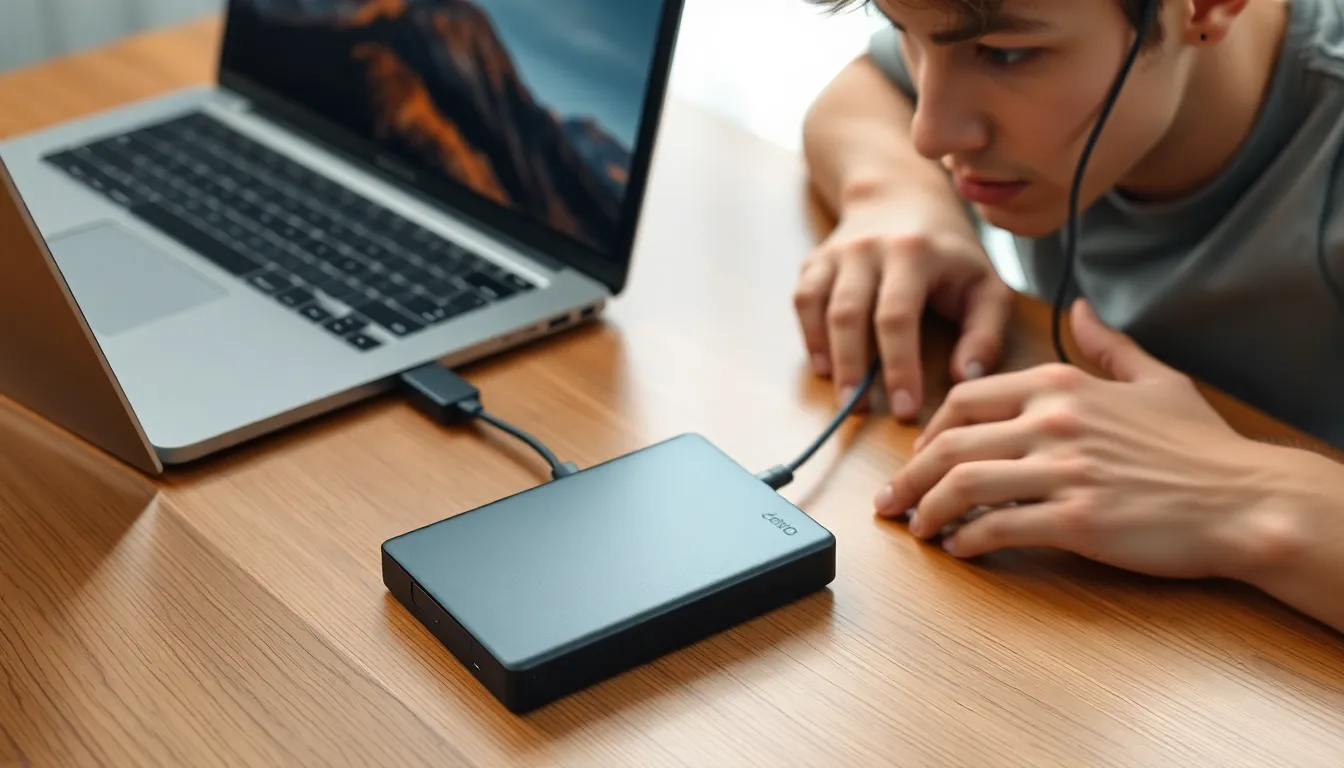Every iPhone user knows the struggle: your phone’s storage is bursting at the seams with photos of your cat in various poses, that perfect sunset, and maybe a few too many snapshots of your lunch. It’s time to reclaim that precious space and save those memories for the long haul. Transferring all those photos to an external hard drive isn’t just smart; it’s essential for keeping your digital life organized.
Table of Contents
ToggleUnderstanding the Need for External Storage
Limited storage on iPhones often becomes a challenge for users. The accumulation of photos quickly fills available space, making it difficult to download new apps or store additional files. Managing these images can lead to frustration, especially when users want to capture new moments.
External storage solutions, such as hard drives, offer a practical way to alleviate storage concerns. Transferring photos to an external hard drive not only frees up space but also helps in organizing digital assets more effectively. Backup options increase, minimizing the risk of losing precious memories due to device failure.
Investing in external storage also enhances the ability to access large files. Users can enjoy more freedom to upload, download, and share photographs across different platforms without worrying about space limitations. Many external drives support high capacities, allowing users to store thousands of images.
Security becomes another consideration for users. Storing photos externally decreases the likelihood of accidental deletion or loss from the iPhone. Having a dedicated backup ensures peace of mind, knowing that important moments are preserved.
Choosing an external hard drive that supports fast data transfer speeds improves the overall experience. Quick backups mean less downtime, allowing users to continue capturing memories without delays. With the right tools, managing digital photos transforms into a streamlined process.
Exploring diverse options for external storage presents an opportunity for personalization. Each user can find a solution that meets specific needs, whether aiming for portability or performance. This strategic approach to managing storage can significantly enhance the iPhone experience.
Preparing Your External Hard Drive

Ensuring the external hard drive is ready for photo transfers requires two essential steps: formatting the drive and selecting the right connection method.
Formatting the Drive
Formatting improves compatibility. External hard drives typically come formatted for Windows systems. Users should reformat their drive to the ExFAT file system, allowing it to work seamlessly with both Windows and macOS. Back up any existing data on the drive before formatting, as this process erases all files. Access the disk management tool on a Windows PC or Disk Utility on a Mac to initiate the formatting process. Select the drive, choose ExFAT as the format type, and follow the prompts to complete the task. This preparation guarantees that the drive supports the large file transfer sizes needed for multiple photos.
Choosing the Right Connection Method
Considering the connection method ensures an efficient transfer experience. USB-C and USB 3.0 provide fast data transfer speeds, making them ideal for photography tasks. USB-C connections support higher transfer rates on compatible devices, significantly reducing overall transfer time. Using USB 3.0 remains a reliable option for those with devices that lack USB-C ports. Check the cable type and the port availability on the device. Opt for direct connections over hubs or adapters to maintain speed and reliability. This careful selection of connection methods contributes significantly to successfully transferring iPhone photos.
Transferring Photos Using a Computer
Transferring photos from an iPhone to an external hard drive through a computer is straightforward. This method ensures efficient management and storage of valuable images.
Using Windows PC
First, connect the iPhone to a Windows PC using a compatible USB cable. Windows should recognize the device automatically. Next, open “File Explorer” and find the iPhone under “This PC.” Locate the “DCIM” folder, which holds all the photos. Users can then select the desired images or folders to transfer, right-click, and choose “Copy.” Finally, navigate to the external hard drive in “File Explorer,” right-click, and select “Paste” to complete the transfer. For seamless operation, ensure that the external hard drive is formatted to ExFAT.
Using Mac
Connect the iPhone to a Mac computer via USB cable. The “Photos” app typically opens automatically. If it doesn’t, open the app manually. Users will see the iPhone listed on the left sidebar. Selecting the device reveals all the images available for import. Choose specific photos or select “Import All New Photos” to transfer everything. Afterward, navigate to the external hard drive, ensuring it is formatted to ExFAT, and drag the imported pictures there. This process guarantees that users safely store their memories on an external drive without loss.
Direct Transfer Using Third-Party Apps
Using third-party apps simplifies the process of transferring iPhone photos to an external hard drive. These apps often streamline the transfer, saving time and ensuring data safety.
Recommended Apps for iPhone
Numerous apps cater to photo transfer needs. Applications like iMazing, PhotoSync, and AnyTrans offer user-friendly interfaces. iMazing allows flexible management of files and provides a direct connection to external drives. PhotoSync supports wireless transfers, simplifying the process without needing a computer. AnyTrans stands out with its comprehensive features for managing iPhone data efficiently. Choosing one of these apps can enhance the overall transfer experience.
Steps to Use Third-Party Apps
Steps for using third-party apps generally follow a straightforward pattern. First, download and install the chosen app on the computer. Next, connect the iPhone using a compatible cable. Afterward, launch the app and grant the necessary permissions to access photos. Users can select the desired photos for transfer within the app. Finally, specify the external hard drive as the destination and execute the transfer. Following these steps ensures a seamless transition of photos to external storage.
Troubleshooting Common Issues
Transferring photos from an iPhone to an external hard drive can encounter several common issues. Users may face connection problems where the iPhone is not recognized by the computer. To resolve this, checking the USB cable for damage and ensuring a secure connection typically helps. Confirming that the latest version of iTunes or Finder is installed may also resolve recognition issues.
Occasionally, users may run into error messages during the transfer process. Outdated software can lead to compatibility concerns. Regularly updating both the computer’s operating system and the iPhone ensures smoother functioning during file transfers.
Insufficient storage space on the external hard drive can create complications. Users should verify available space before initiating transfers. If the hard drive is full, deleting unneeded files can free up space for new content.
Another issue involves the file format of the transferred images. Some external drives may require specific file formats. Converting images to a universally accepted format like JPEG may prevent accessibility problems.
Photo transfer speeds may be slower than expected. Users should consider using a high-speed USB-C or USB 3.0 connection. Choosing the right cable type ensures optimal transfer speeds, making the experience more efficient.
Permissions settings on the iPhone may block access to photos. Granting necessary permissions can enable smooth access. Checking the settings ensures that the device allows photo access for any third-party apps being used.
Lastly, app-related issues can arise when using third-party applications. Issues such as incomplete installations or outdated features may hinder the process. Uninstalling and reinstalling the app often resolves persistent problems, leading to a successful transfer.
Transferring photos from an iPhone to an external hard drive is a practical solution for managing storage space and safeguarding cherished memories. By utilizing the right methods and tools users can streamline the process and maintain an organized digital life.
Choosing a compatible external hard drive and understanding the necessary steps ensures a smooth transfer experience. Whether opting for a direct connection through a computer or using third-party apps, the key is to prioritize efficiency and security.
With these strategies in place users can enjoy their iPhone without the constant worry of running out of storage, allowing them to focus on capturing new moments.


